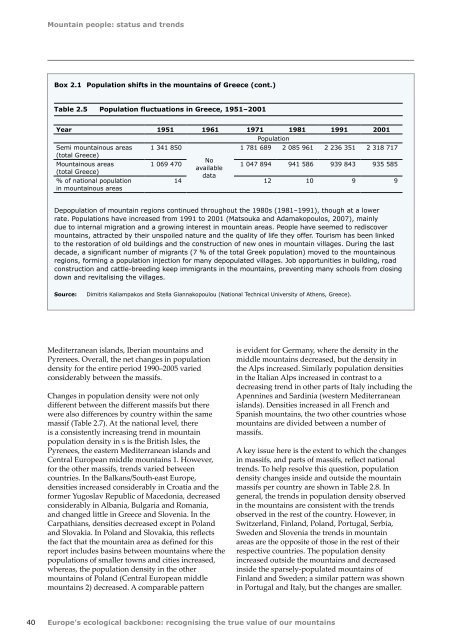Europes ecological backbone.pdf
Europes ecological backbone.pdf
Europes ecological backbone.pdf
You also want an ePaper? Increase the reach of your titles
YUMPU automatically turns print PDFs into web optimized ePapers that Google loves.
Mountain people: status and trends<br />
Box 2.1 Population shifts in the mountains of Greece (cont.)<br />
Table 2.5 Population fluctuations in Greece, 1951–2001<br />
Year 1951 1961 1971 1981 1991 2001<br />
Population<br />
Semi mountainous areas 1 341 850<br />
1 781 689 2 085 961 2 236 351 2 318 717<br />
(total Greece)<br />
No<br />
Mountainous areas<br />
1 069 470 1 047 894 941 586 939 843 935 585<br />
available<br />
(total Greece)<br />
data<br />
% of national population<br />
14 12 10 9 9<br />
in mountainous areas<br />
Depopulation of mountain regions continued throughout the 1980s (1981–1991), though at a lower<br />
rate. Populations have increased from 1991 to 2001 (Matsouka and Adamakopoulos, 2007), mainly<br />
due to internal migration and a growing interest in mountain areas. People have seemed to rediscover<br />
mountains, attracted by their unspoiled nature and the quality of life they offer. Tourism has been linked<br />
to the restoration of old buildings and the construction of new ones in mountain villages. During the last<br />
decade, a significant number of migrants (7 % of the total Greek population) moved to the mountainous<br />
regions, forming a population injection for many depopulated villages. Job opportunities in building, road<br />
construction and cattle-breeding keep immigrants in the mountains, preventing many schools from closing<br />
down and revitalising the villages.<br />
Source:<br />
Dimitris Kaliampakos and Stella Giannakopoulou (National Technical University of Athens, Greece).<br />
Mediterranean islands, Iberian mountains and<br />
Pyrenees. Overall, the net changes in population<br />
density for the entire period 1990–2005 varied<br />
considerably between the massifs.<br />
Changes in population density were not only<br />
different between the different massifs but there<br />
were also differences by country within the same<br />
massif (Table 2.7). At the national level, there<br />
is a consistently increasing trend in mountain<br />
population density in s is the British Isles, the<br />
Pyrenees, the eastern Mediterranean islands and<br />
Central European middle mountains 1. However,<br />
for the other massifs, trends varied between<br />
countries. In the Balkans/South-east Europe,<br />
densities increased considerably in Croatia and the<br />
former Yugoslav Republic of Macedonia, decreased<br />
considerably in Albania, Bulgaria and Romania,<br />
and changed little in Greece and Slovenia. In the<br />
Carpathians, densities decreased except in Poland<br />
and Slovakia. In Poland and Slovakia, this reflects<br />
the fact that the mountain area as defined for this<br />
report includes basins between mountains where the<br />
populations of smaller towns and cities increased,<br />
whereas, the population density in the other<br />
mountains of Poland (Central European middle<br />
mountains 2) decreased. A comparable pattern<br />
is evident for Germany, where the density in the<br />
middle mountains decreased, but the density in<br />
the Alps increased. Similarly population densities<br />
in the Italian Alps increased in contrast to a<br />
decreasing trend in other parts of Italy including the<br />
Apennines and Sardinia (western Mediterranean<br />
islands). Densities increased in all French and<br />
Spanish mountains, the two other countries whose<br />
mountains are divided between a number of<br />
massifs.<br />
A key issue here is the extent to which the changes<br />
in massifs, and parts of massifs, reflect national<br />
trends. To help resolve this question, population<br />
density changes inside and outside the mountain<br />
massifs per country are shown in Table 2.8. In<br />
general, the trends in population density observed<br />
in the mountains are consistent with the trends<br />
observed in the rest of the country. However, in<br />
Switzerland, Finland, Poland, Portugal, Serbia,<br />
Sweden and Slovenia the trends in mountain<br />
areas are the opposite of those in the rest of their<br />
respective countries. The population density<br />
increased outside the mountains and decreased<br />
inside the sparsely-populated mountains of<br />
Finland and Sweden; a similar pattern was shown<br />
in Portugal and Italy, but the changes are smaller.<br />
40 Europe's <strong>ecological</strong> <strong>backbone</strong>: recognising the true value of our mountains

















